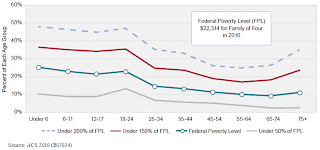In addition to the loss of manufacturing is another "manufacturing" crisis.
The future of the United States economy is further threatened by reduced birth rates. Upon the onset of the recession of 2008 birth rates slumped to their lowest level since the 1920s. Naturally, this is a double whammy, so to speak.
The general populous may believe low birth rates, especially births among those citizens in lower income levels, would benefit the strain on the U.S. economy. Considering more government assistance and social programs would be required to sustain new births, the myth builds steam. However, the opposite is true as Baby Boomers age, nearing retirement. A confluence of low births and loss of jobs will adversely harm future America.
Over 78 million Baby Boomers are beginning to retire, the oldest of the Boomers have reached 67 this year. USA Today reports, "The recent decline, fueled largely by a deep recession and slower immigration, has pushed the U.S. fertility rate below the 2.1 "replacement level'' — the number of children women are expected to have in their lifetime if current rates continue and the number needed to keep the population stable
.
The slowdown is worrisome to many because of the growing gap between working-age populations that fund social programs and the elderly who rely on them.
In a study conducted by the University of Southern California, in 2010, a total of 9,295,040 children under the age of 18 resided in California.
The percentage of the state's population that comprises children has been declining markedly since at least 1970 and is projected to continue falling in coming decades.
Between 2010 and 2040 the senior ratio will rise dramatically, according to every forecast. After remaining constant since 1970 at 20 or 21 seniors per 100 working age adults, the ratio rises in California to 28 in 2020, and then to 36 a decade later.
California's most valuable asset for a flourishing future is its children. After decades of burgeoning population and economic growth, however, the state now faces a very different prospect.
This report provides a summary of California's demographics based on the most recent census data, and finds that dramatic changes are under way among California's children.
Growth trends have shifted and children's life circumstances have been altered in significant ways. The most salient finding is that children have been declining in number, concentrating initially under age 10 but now spreading to all those under age 18.
The study concludes this is affecting the United States as a whole, not only the State of California. "Racial and ethnic diversity is well established among California’s children, foreshadowing what is
expected for the nation as a whole in coming decades.
Read the full report here: http://www.kidsdata.org/childpop/childpop-report_01-03-13.pdf
The imbalance between children and retirees is growing. The
economic burden on a child born in 2015 will be nearly twice that of a
child born in 1985, according to the USC study.
Dowell Myers, a demographer for the University of Southern California predicts, "a drop off in taxpayers, more people selling homes, fewer people buying homes. One of the most important strategies is invest in the younger generation, the human capital," Myers says. "We can actually survive with fewer kids but we need to bring them along ... At the end of the decade, when Baby Boomer retirement hits us really hard, at that point we'll be begging for workers."
Dowell Myers, a demographer for the University of Southern California predicts, "a drop off in taxpayers, more people selling homes, fewer people buying homes. One of the most important strategies is invest in the younger generation, the human capital," Myers says. "We can actually survive with fewer kids but we need to bring them along ... At the end of the decade, when Baby Boomer retirement hits us really hard, at that point we'll be begging for workers."
Although Myers says we will be begging for workers, where will those workers hold jobs if our decline of manufacturing and exporting of goods continues a downward spiral? If an increased population creates a greater ratio of individuals with innovative ideas and creativity, then using that reasoning, an increase of children born in this Country is one of our best investments.
Therefore, other events must occur, bring manufacturing back to the United States, narrow the trade deficit with other countries, largely China and encourage tricycle motor manufacturing among families.
Therefore, other events must occur, bring manufacturing back to the United States, narrow the trade deficit with other countries, largely China and encourage tricycle motor manufacturing among families.
Contributing Editor: S. Rothe' du Bois




No comments:
Post a Comment